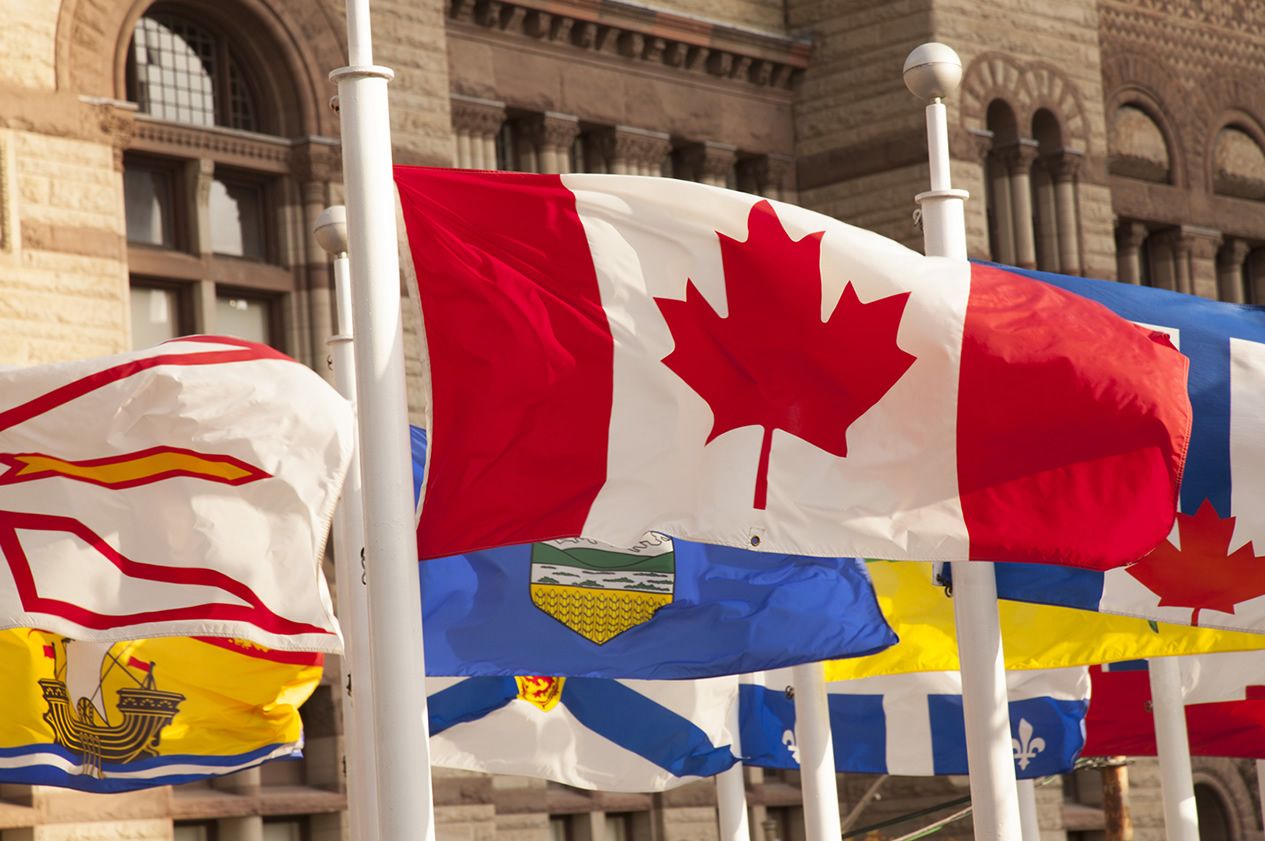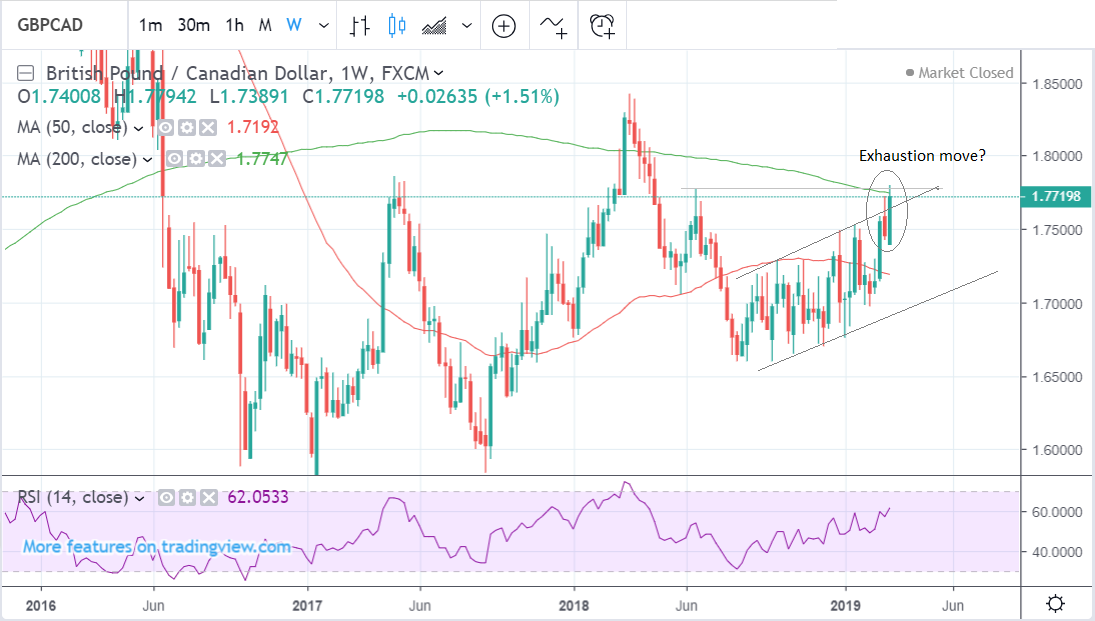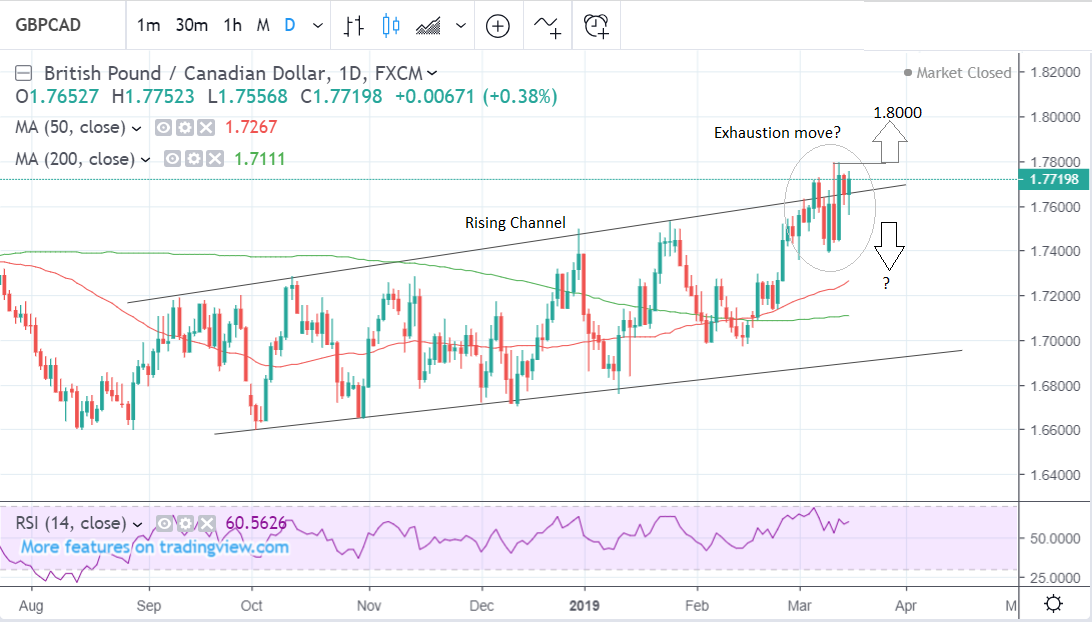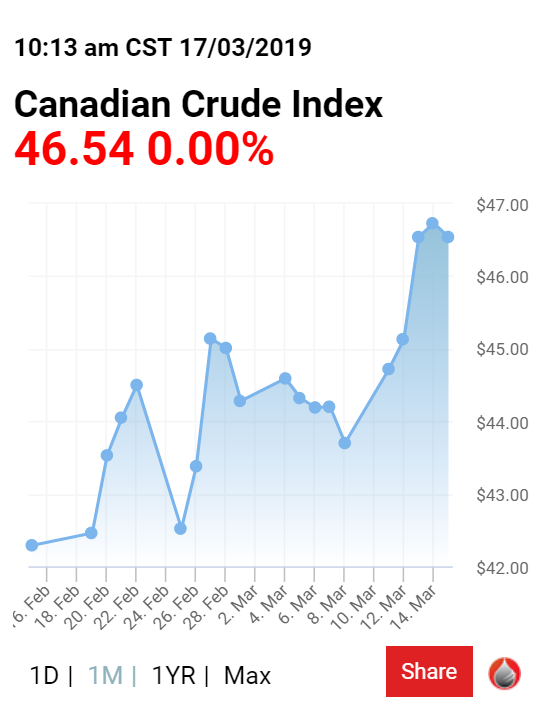The Pound-to-Canadian-Dollar Rate in the Week Ahead: Break Above Channel Highs

Image © Viv Idrange, Adobe Stock
- GBP/CAD breaks bullishly above channel highs
- But move could also be a signal of GBP exhaustion
- Brexit vote to be main mover of GBP; CAD eyes oil price
The Pound-to-Canadian Dollar rate is to begin trading around 1.7719 Sunday after rising more than 1.5% in the previous week, although technical studies of the charts suggest the exchange rate is close to having exhausted its uptrend.
Sterling rose as a result of a stronger Pound after the option of a ‘no-deal’ Brexit was taken off the table following a series of votes by Parliament. First lawmakers rejected Theresa May’s exit deal again, then they rejected the possibility of a Brexit without a formal agreement and finally, they voted for an extension of the Article 50 window.
The rejection of the no-deal option and request for an extension of Article 50 were the main drivers of Sterling's gains, which pushed the GBP/CAD exchange rate to a new high of 1.7794 on Wednesday.

Above: Pound-to-Canadian-Dollar rate shown at weekly intervals.
From a technical standpoint, the outlook is mixed. GBP/CAD rose up and broke out above the top of a long-term sideways range and this could either be a bullish sign or a sign of exhaustion - which it is remains to be seen.
The pair also rose up and re-touched the 200-week Moving Average (MA) at 1.7747 and this is a major resistance area which could act as a hard ceiling to the pair leading to reversal lower.
Yet despite the possibility this may be an exhaustion move and the factor of the obstructive 200-week MA, the short-term uptrend is intact and the pair may very well go higher, thus a break above the 1.7794 highs is likely to open the way to further upside to a target at 1.8000.

Above: Pound-to-Canadian-Dollar rate shown at daily intervals.
The Canadian Dollar: What to Watch
The main data releases for the Canadian Dollar (Loonie) are on Friday when inflation and retail sales are released.
Inflation is forecast to rise 0.6% in February from 0.1% in the previous month. This would likely translate into a 1.5% yearly rise (from 1.4% before). A higher inflation rate would be expected to increase interest rates and appreciate the Loonie; this is due to higher interest offered attracting and keeping greater inflows of foreign capital.
The other main release on the calendar is retail sales which is expected to show a 0.4% rise in January after declining -0.1% in December. Higher retail sales is usually indicative of growth and supportive of the currency.
Another key driver of the Loonie is the price of crude oil, especially Canadian oil.
The Canadian oil index rose quite strongly in the last week, rising back above the $45 level where it had been trading for several weeks, and ending the week trading in the mid $46s. Canadian oil is in a uptrend which continues. This is broadly supportive of the currency.
The gains were attributable to the news OPEC had decided to continue cutting global supply, which drove up the market as a whole.
A global supply deficit and U.S. sanctions on Iran and Venezuela are factors keeping oil prices higher.

Above: Canadian Crude Index as shown on oilprice.com
The Pound: What to Watch
The main fundamental driver for the Pound in the week ahead is probably developments in the Brexit process, with the Bank of England (BOE) meeting on Thursday also likely to cause volatility.
It is highly likely that the government will try, for the third time, to get its Brexit deal approved by Parliament, or failing that, that the EU will require a lengthy delay of article 50.
The latest reports from Brussels are suggesting the EU may try to make a delay conditional on either the UK having a second referendum, a general election or a very firm plan.
It is suggested this may focus minds, especially amongst Brexiteers who could fear a hijacking of Brexit if there is a delay. This will put pressure on them to accept the government’s negotiated deal.
The two most likely scenarios, therefore, are that Theresa May’s deal finally gets approved on a third attempt, or that Brexit is delayed on the condition of a referendum or general election being held.
Both would be very positive for the Pound, which compliments the overall bullish technical outlook.
The BOE meeting on Thursday, at 12.00 GMT, could also impact on Sterling. There is a risk the BOE may change its statement to reflect the recent slowdown in the economy. If so the Pound is likely to suffer.
Up until now, it had been assumed Brexit risks were the only thing stopping the BOE from raising interest rates, but the slowing economy may be providing them with other reasons not to.
“The economy has no doubt slowed but the Bank seems unwilling to shift to a more dovish stance, reasoning that it should just be patient for now as an ‘orderly’ Brexit outcome can dispel much of the uncertainty by itself and hence, kickstart investment and growth. Overall, the BoE is unlikely to deviate much from this stance, but if there is any change, it’ll probably be towards a more cautious bias,” says Raffi Boyadjian, an economist at XM.com.
From a purely hard data perspective, the main releases are employment data out on Tuesday, inflation data out on Wednesday and retail sales on Thursday.
Labour market data is expected to continue showing signs of strength, when released on Tuesday at 9.30. The unemployment claimant count is expected to have risen by only 2.7k in February - a relatively low count - the unemployment rate is forecast to be stuck at a historic low of 4.0% in January, and overall payroll count to have risen by 120k in December, according to consensus estimates.
More important for Sterling, perhaps, is average earnings in January, since this has more influence over Bank of England (BOE) policy.
If average earnings rise more than the 3.4% in January (3.2% including bonuses) that is forecast, inflation will probably rise and so will interest rates - with expectations increasing that the BOE will raise them, and this will drive Sterling higher. Higher interest rates are positive for the Pound because they attract and keep greater inflows of foreign capital.
Inflation is out on Wednesday and is another key metric for the Pound. As explained above inflation influences BOE policy which impacts on the currency. In January inflation came out surprisingly lower after falling -0.8% compared to December. If inflation is also shown to be negative in February it could really drive down the Pound. Current expectations, however, are for a 0.2% rise.
Thursday sees another major data release, in the form of retail sales in February, out at 9.30. This is forecast to show a -0.3% fall from 1.0% previously. A deeper-than-expected decline, however, could trigger more weakness for Sterling.
Time to move your money? Get 3-5% more currency than your bank would offer by using the services of foreign exchange specialists at RationalFX. A specialist broker can deliver you an exchange rate closer to the real market rate, thereby saving you substantial quantities of currency. Find out more here.
* Advertisement




